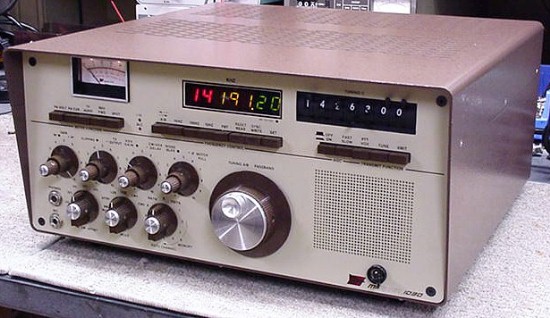|
|
Signal/One Milspec 1030 Transceiver |
|
|
Signal/One Milspec 1030 Transceiver |

|
The Milspec 1030 followed the CX-7 and CX-11 top-of-the-line transceivers made by Signal/One. The "introductory" price of the radio shown above was $5740. As its name and pricetag suggest, the Milspec 1030 was manufactured to unusually high quality standards. |
|
|
|
Under the hood of the Milspec 1030. The optional fan assembly over the heat sinks has two thermostatically controlled muffin fans.
|
Introduced in 1981, The Milspec 1030 was an effort to upstage the popular Collins KWM-380 transceiver (above) with a second-generation synthesizer design. The '1030' shown on this page is one of the latest (1984) production radios. The Milspec 1030's front panel clearly resembles that of the KWM-380, with front-mounted speaker, meter, button, knob and display layouts closely mimicing the Collins styling. The large black power toggle switch is identical to that used in the Collins. |
|
|
Electrically, the Milspec 1030 offers numerous improvements over the earlier Collins design. Available with either 150 or 200 watts output, the Milspec 1030 has excellent CW cperating characteristics, including variable power output, passpand tuning, adjustable noise blanker, and full QSK keying using a Jennings RJ1A vacuum relay. The transceiver features dual VFOs and eight memories. It is also capable of computer-control. Earlier Signal/One transceivers had been known for their powerful transmit audio, thanks to a sophisticated adjustable r.f. clipping circuit. The Milspec 1030 continues this tradition and has, perhaps, the most "talk power" of any ssb transceiver, before or after. |
||
|
Underchassis view of the Milspec 1030, with shield covers removed. All circuit boards are double-sided glass-epoxy construction. The transceiver is built to mil-spec quality. |
Description: The Milspec 1030 covers 10 kHz - 30 MHz, with fully synthesized frequency control, based on CMOS ICs. It uses a double-conversion design, with a first IF of 40.455 MHz and a 2nd IF of 455 kHz. First IF selectivity is provided by an 8-pole crystal filter, while up to six Collins mechanical filters provide 2nd IF selectivity. The front-end uses a special passive double-balanced mixer, with a 3rd-order intercept point of +20 dbm. |
|
|
The power supply uses a tape-wound hypersil transformer which provides excellent voltage regulation and light weight. Even so, the transceiver weighs 50 lbs.
The rear panel of the Milspec 1030 has multiple outputs for amplifiers, panadaptors, transverters, etc. Provision is also made for an external 1 MHz frequency standard, for ultra-high precision tuning. |
Design Features: All internal frequency controls, including the variable BFO are derived from a single 1 MHz crystal standard. Operating frequency is displayed to 10 Hz resolution on 0.43 inch seven-segment displays. Three-color displays were optional. Internally, the transceiver uses modular construction, with ribbon interconnect cables and teflon wiring. Early production radios used transistor sockets, but later radios used soldered-in transistors. |
|
|
Styling: Although the general appearance of the Milspec 1030 resembles that of the KWM-380, the Signal/One rig lacks the heavy cast trim ring and molded smoked bezel of the Collins radio. Although this styling difference gives the Milspec 1030 a less tailored visual appearance, some prefer the look to that of the Collins transceiver. The KWM-380 was criticized initially for resembling a business-band radio. Click HERE to see full specs of the Milspec 1030, and HERE to go to the Signal/One website for information about the custom-made hybrid Icom 781/Milspec 1030 transceiver.
Page count since June 1, 2000. Cunters provided by Honesty.com. |
||
|
The 455 kHz second IF makes extensive use of Rockwell/Collins mechanical filters. The vacant slot is intended for an optional AM filter, which is not really needed since the first IF uses an 8-pole crystal filter with a 7 kHz bandwidth. |
||
|
Operating Impressions: I find the the Milspec 1030 takes a bit of practice to master. Some features, such as the passband tuning (which uses the main tuning dial) and the memory read/write controls seem initially strange until one gains familiarity. The inner concentric knobs are a bit small for my taste. The lever switches are a clever innovation, replacing a conventional bandswitch. Although some Signal/One diehards prefer the CX-11A for CW operation, I think the Milspec 1030 is a great CW machine. All-in-all, I enjoy using the radio. |
||